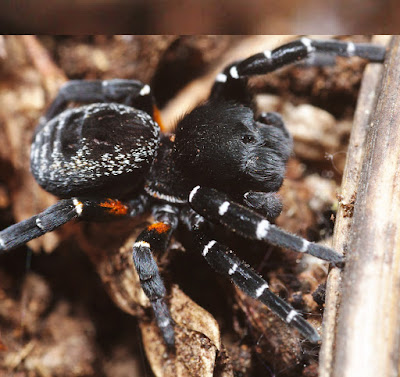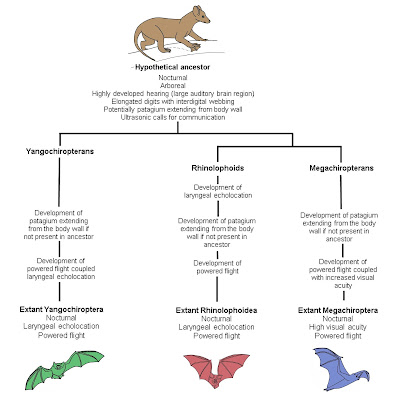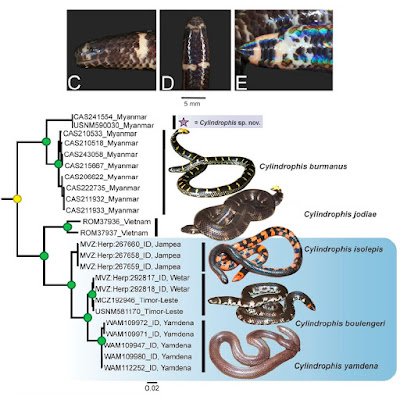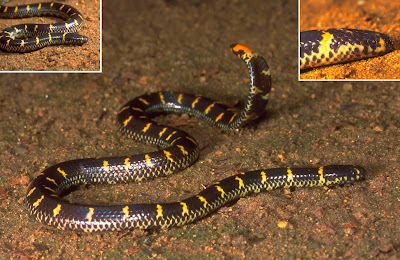[Most Recent Entries] [Calendar View]
Saturday, September 12th, 2020
| Time | Event | ||||||
| 9:30a | [Arachnida • 2020] A Black Sheep in Eresus (Araneae: Eresidae): Taxonomic Notes on the Ladybird Spiders of Iran and Turkey, with A New Species
Abstract New taxonomic data are provided on the ladybird spider genus Eresus Walckenaer, 1805 in Turkey and Iran. Eresus adaleari Zamani & Szűts, sp. n. is described as a new species, on the basis of a single male specimen collected in Semnan Province, northeastern Iran, and Eresus lavrosiae Mcheidze, 1997, previously known solely from the original description of the male holotype from Georgia, is re-described on the basis of one newly collected male specimen from Kars Province, eastern Turkey. Both of these species are generally dark-colored, which contrasts with the usual coloration of males of this genus. Finally, a few methods and suggestions that might accelerate and improve taxonomic procedures for studying this group are discussed. Keywords: Araneae, Caucasus, Middle-East, re-description, taxonomy, velvet spiders Eresus cf. kollari Rossi, 1846 Alireza Zamani, Çağatay Altin and Tamás Szűts. 2020. A Black Sheep in Eresus (Araneae: Eresidae): Taxonomic Notes on the Ladybird Spiders of Iran and Turkey, with A New Species. Zootaxa. 4851(3); 559–572. DOI: 10.11646/zootaxa.4851.3.6 | ||||||
| 1:41p | [Mammalogy • 2020] The Evolution of Flight in Bats: A Novel Hypothesis
Abstract Bats (order Chiroptera) are the only mammals capable of powered flight, and this may be an important factor behind their rapid diversification into the over 1400 species that exist today – around a quarter of all mammalian species. Though flight in bats has been extensively studied, the evolutionary history of the ability to fly in the chiropterans remains unclear. We provide an updated synthesis of current understanding of the mechanics of flight in bats (from skeleton to metabolism), its relation to echolocation, and where previously articulated evolutionary hypotheses for the development of flight in bats stand following recent empirical advances. We consider the gliding model, and the echolocation‐first, flight‐first, tandem development, and diurnal frugivore hypotheses. In the light of the recently published description of the web‐winged dinosaur Ambopteryx longibrachium, we draw together all the current evidence into a novel hypothesis. We present the interdigital webbing hypothesis: the ancestral bat exhibited interdigital webbing prior to powered flight ability, and the Yangochiroptera, Pteropodidae, and Rhinolophoidea evolved into their current forms along parallel trajectories from this common ancestor. Thus, we suggest that powered flight may have evolved multiple times within the Chiroptera and that similarity in wing morphology in different lineages is driven by convergence from a common ancestor with interdigital webbing. Keywords: bats, Chiroptera, echolocation, evolution of flight, interdigital webbing, pterosaurs, Scansoriopterygidae
CONCLUSION: The ability of some vertebrates to take flight has been studied in a range of scientific disciplines, and yet the evolutionary journey of chiropterans from small arboreal mammals to the adept flyers we know today has never been laid out definitively. The story is inherently more complex than that of other vertebrate flyers such as birds, thanks to the close coupling of flight and echolocation in many bat species, and the evolution of flight in bats cannot be uncovered without taking this into account. With advances in molecular analyses, the phylogenetic tree of chiropterans is becoming clearer; the Rhinolophoidea is emerging as unique, not only in morphology and behaviour, but also in phylogeny. Many hypotheses for the evolution of flight in bats remain viable, but we present a novel hypothesis which synthesises current understanding of chiropteran flight, phylogeny and evolution: that the ancestral bat exhibited interdigital webbing, and that the Yangochiroptera, Pteropodidae, and Rhinolophoidea evolved into their current forms along parallel trajectories from this common ancestor. Drawing on comparisons from the vertebrates, and in the light of the recently published description of the membrane‐winged dinosaur Ambopteryx longibrachium, this interdigital webbing hypothesis provides a biologically satisfying narrative for the evolution of flight in bats, from arboreal mammals to the fastest‐flying vertebrates that we know of. In comparison with some previous hypotheses, this novel hypothesis may be less parsimonious, but we feel it offers the best fit to currently available empirical evidence. Further evidence could strengthen support for this hypothesis, or falsify it. Sophia C. Anderson and Graeme D. Ruxton. 2020. The Evolution of Flight in Bats: A Novel Hypothesis. Mammal Review. DOI: 10.1111/mam.12211 | ||||||
| 2:35p | [Herpetology • 2020] Cylindrophis slowinskii • Molecular Phylogeny of Asian Pipesnakes, Genus Cylindrophis Wagler, 1828 (Squamata: Cylindrophiidae), with the Description of A New Species from Myanmar
Abstract Cylindrophis is a genus of secretive, semi-fossorial, non-venomous snakes comprising 14 species, characterized by a generally cylindrical body, uniform scales (with barely enlarged ventrals), and vestiges of pelvic and limb bones, the latter terminating in a claw lateral to the vent. We reconstructed a concatenated molecular phylogeny of seven taxa of Cylindrophis taxa based on one nuclear (R35) and two mitochondrial (16S, ND2) genes. Analyses recovered the Sri Lankan endemic C. maculatus as sister to all other sampled Cylindrophis. The mainland Southeast Asian species C. burmanus and C. jodiae form successive sister lineages to a monophyletic Wallacean island group containing C. boulengeri, C. isolepis, and C. yamdena. We also describe a new species of Cylindrophis, morphologically similar to C. burmanus, from Kachin State in northern Myanmar. Cylindrophis slowinskii sp. nov. is distinguished from all congeners by the following combination of characters: 19 dorsal scale rows at midbody, 216–220 ventrals, eight subcaudals, a dark venter with > 60 very narrow diffuse pale blotches, and a pale bar running along the posterior border of the prefrontals. In our phylogeny, the new species is strongly supported as the sister species of C. burmanus. It is the 15th currently recognised species in the genus, and the fourth from mainland Southeast Asia. Keywords: Reptilia, Chindwin River, Irrawaddy River, phylogenetics, Reptilia, Serpentes, species complex, systematics, taxonomy Cylindrophis slowinskii sp. nov. Etymology. The specific epithet is a patronym to honour the American herpetologist Joseph Bruno “Joe” Slowinski (1962–2001) and his pioneering work on herpetofauna, especially in Myanmar. In 2001, Joe led a multidisciplinary expedition to Kachin State, Myanmar, the type locality of the new species described herein. For biographical details see Donnelly & Crother (2003) and James (2008). Suggested common names. Slowinski’s Pipesnake (English), Slowinski-Walzenschlange (German),
Justin M. Bernstein, Aaron M. Bauer, Jimmy A. McGuire, Evy Arida, Hinrich Kaiser, Max Kieckbusch and Sven Mecke. 2020. Molecular Phylogeny of Asian Pipesnakes, Genus Cylindrophis Wagler, 1828 (Squamata: Cylindrophiidae), with the Description of A New Species from Myanmar. Zootaxa. 4851(3); 535–558. DOI: 10.11646/zootaxa.4851.3.5 |
| << Previous Day |
2020/09/12 [Calendar] |
Next Day >> |








